As the days shorten and a chill enters the air, many gardeners feel the familiar urge to “tidy up” their outdoor spaces. For those of us with balconies, patios, or small yards, the temptation to prune every spent bloom and clear every fallen leaf is strong. You want your small space to look neat and ready for winter, but what if I told you that a little bit of strategic messiness could transform your balcony into a vital sanctuary for the unsung heroes of your garden: beneficial insects?
You play a crucial role in supporting the tiny creatures that pollinate your plants, control pests, and enrich your local ecosystem. Creating a simple winter shelter for beneficial insects in your balcony pots requires minimal effort and offers immense ecological rewards. This article guides you through exactly how to do it, offering practical, actionable insights tailored for your small-space garden.
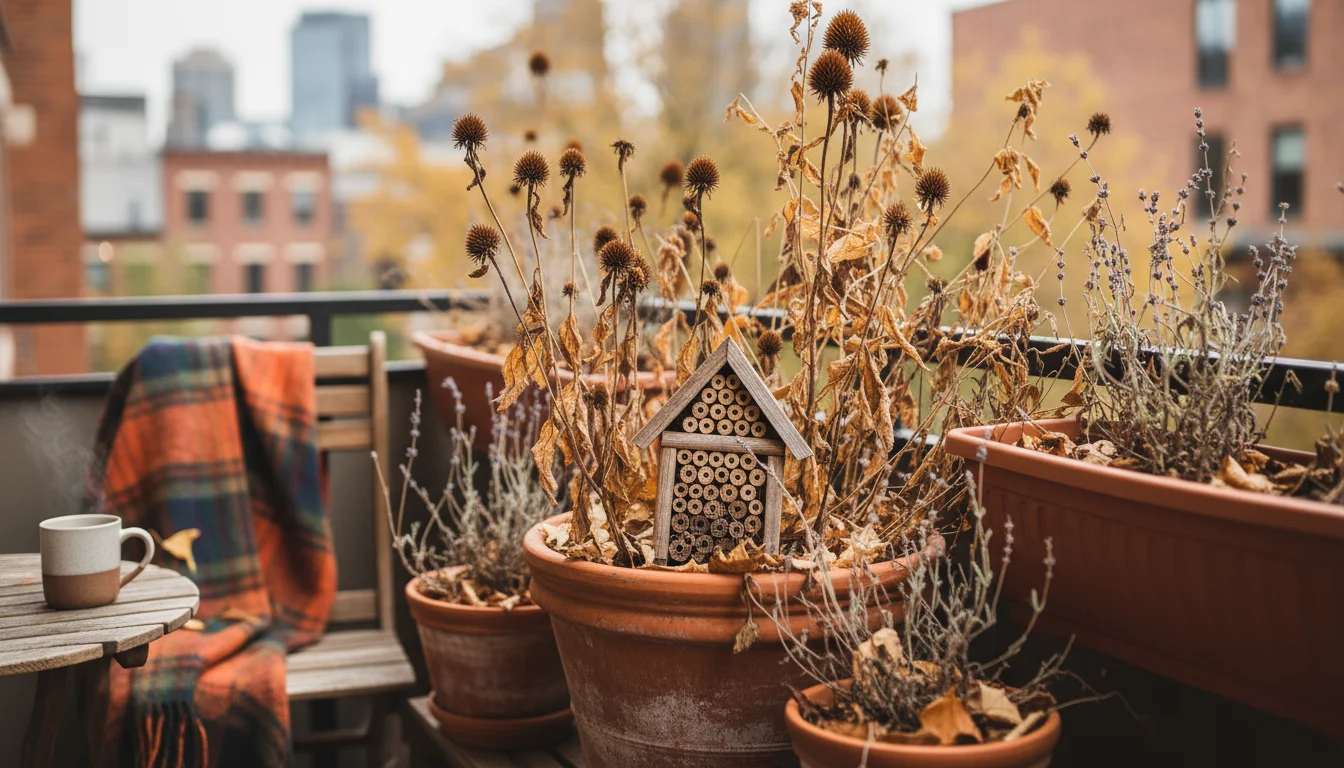
Why Your Balcony Needs a Winter Habitat
Your balcony garden, no matter its size, forms a vital part of a larger ecological network. While you enjoy the vibrant flowers and fresh herbs during warmer months, countless beneficial insects work tirelessly behind the scenes. They pollinate your tomatoes, keep aphids off your basil, and contribute to the health of your local environment. However, when winter arrives, these essential creatures face harsh conditions. Urban and suburban landscapes, often characterized by clean, manicured spaces, offer few natural hiding spots for them to survive the cold, wind, and lack of food.
Creating a dedicated beneficial insect shelter provides these creatures with the protection they need to overwinter successfully. This simple act directly supports local biodiversity, ensuring that pollinators and pest controllers return to your garden, and surrounding areas, when spring arrives. Research indicates a significant decline in insect populations globally, a trend that impacts ecosystems and food security. Your small balcony can become a critical refuge, a tiny but mighty winter garden habitat, offering a lifeline to insects struggling to find safe haven.
Many beneficial insects, including several species of native bees, ladybugs, and lacewings, do not migrate. Instead, they find sheltered spots to enter a dormant state, either as adults, larvae, or eggs. Without these safe spaces, many perish, leading to fewer helpful insects in the spring. Your commitment to leaving some natural debris, or actively creating a small bug hotel, helps directly reverse this trend in your immediate vicinity. This proactive approach supports your plants’ health, reduces the need for chemical interventions, and contributes to a more resilient ecosystem.
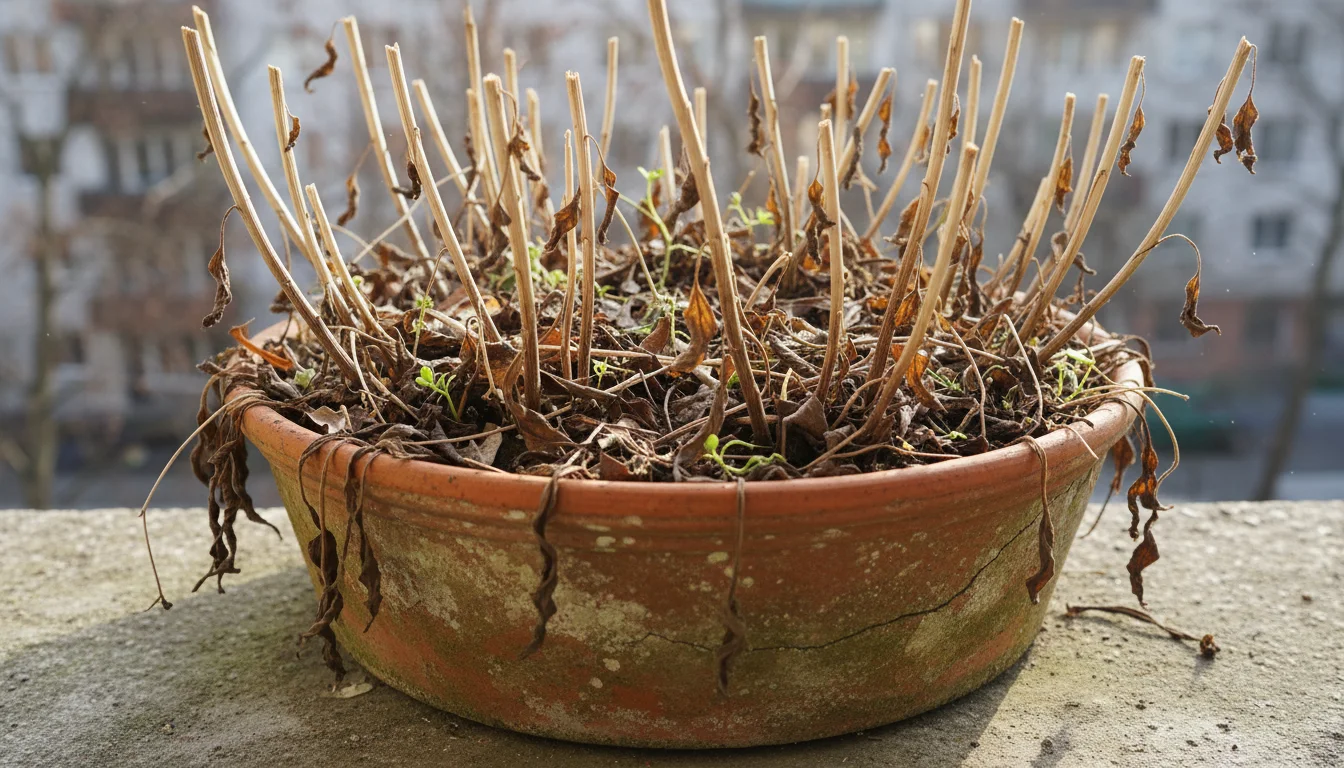
Understanding Your Winter Guests: Who Are You Helping?
Before you start “un-tidying” your balcony, understanding who you are trying to help makes the process more meaningful. Numerous beneficial insects utilize plant stems and leaf litter as crucial overwintering sites. Knowing your potential tenants helps you tailor your winter garden habitat for maximum impact. Here are some of the most common beneficial insects that benefit from your efforts:
- Solitary Bees: Unlike honeybees, solitary bees, such as mason bees and leafcutter bees, do not live in hives. Female solitary bees lay their eggs in hollow plant stems or tunnels, sealing each egg with a pollen ball. The larvae then develop inside these chambers over winter, emerging as adults in spring. Hollow stems of plants like sunflowers, coneflowers, and even ornamental grasses provide ideal nurseries. Supporting these bees directly contributes to your balcony pollinator garden efforts, as they are incredibly efficient pollinators.
- Ladybugs: Both adult ladybugs and their larvae are voracious predators of aphids and other soft-bodied pests. Adult ladybugs often overwinter in dense clusters within leaf litter, under bark, or inside hollow stems. Providing ample leaf litter and undisturbed plant material gives them the perfect spot to escape the cold.
- Lacewings: The larvae of green lacewings are significant predators of aphids, mites, and other small garden pests. Adult lacewings typically overwinter in sheltered locations, including hollow stems or dense plant debris. Their delicate green bodies are a welcome sight in any garden once spring arrives.
- Hoverflies: Often mistaken for small bees, adult hoverflies are excellent pollinators. Their larvae, however, are another powerful ally against aphids, consuming hundreds of them during their development. Some species overwinter as pupae on plant stems or in the soil, while others as adults in protected nooks.
- Ground Beetles: These nocturnal predators patrol the soil surface, feeding on slugs, snails, cutworms, and other destructive pests. They often burrow into loose soil or hide under leaf litter and plant debris to overwinter.
By providing shelter, you are not just vaguely helping “bugs,” you are specifically nurturing populations of your garden’s most effective workers. You create a continuous cycle of life that sustains your plants and enhances your outdoor space naturally. This is a practical way of knowing how to help bees in winter and many other invaluable insect species.
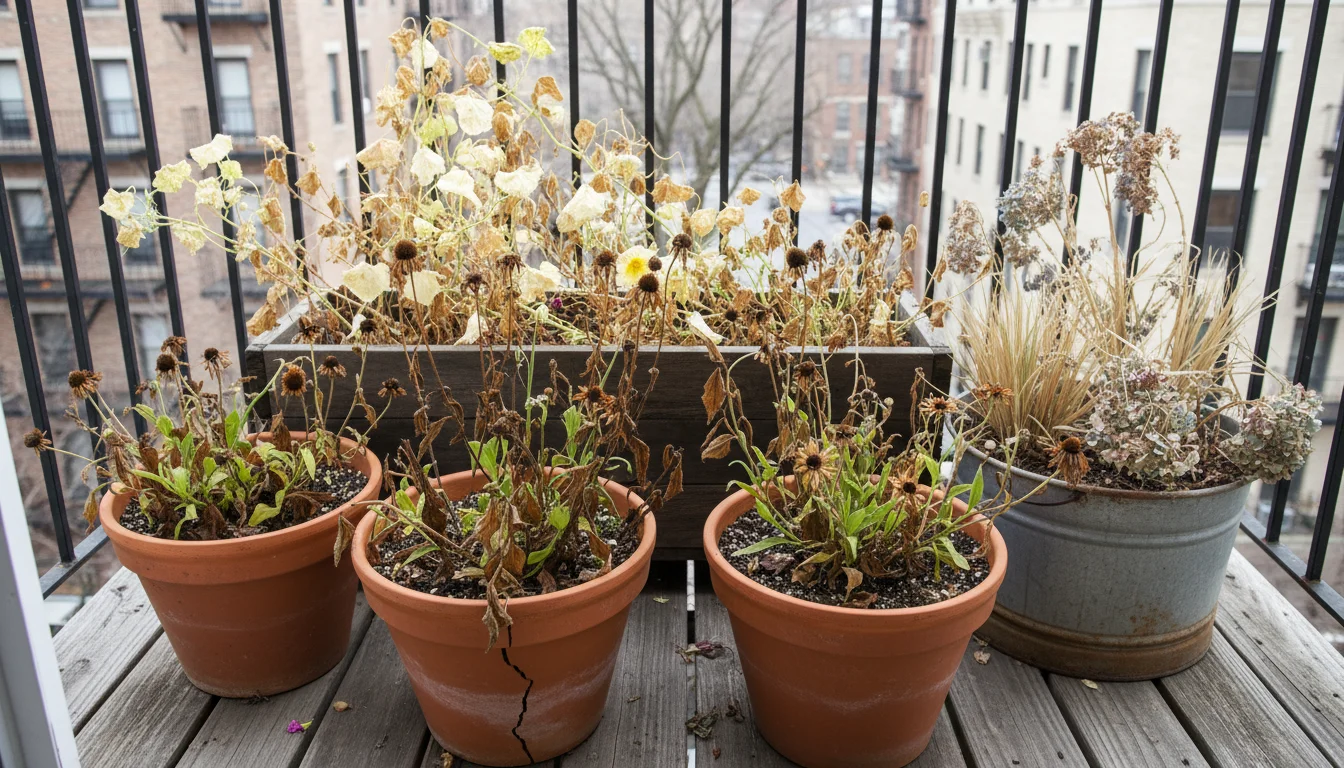
The “Untidy” Garden Approach: What to Leave (and What Not To)
The core principle of creating a winter habitat for beneficial insects is deceptively simple: do less tidying. Instead of cutting everything back to the ground in fall, you strategically leave certain plant materials in place. This approach provides ready-made shelters without requiring you to build anything from scratch.
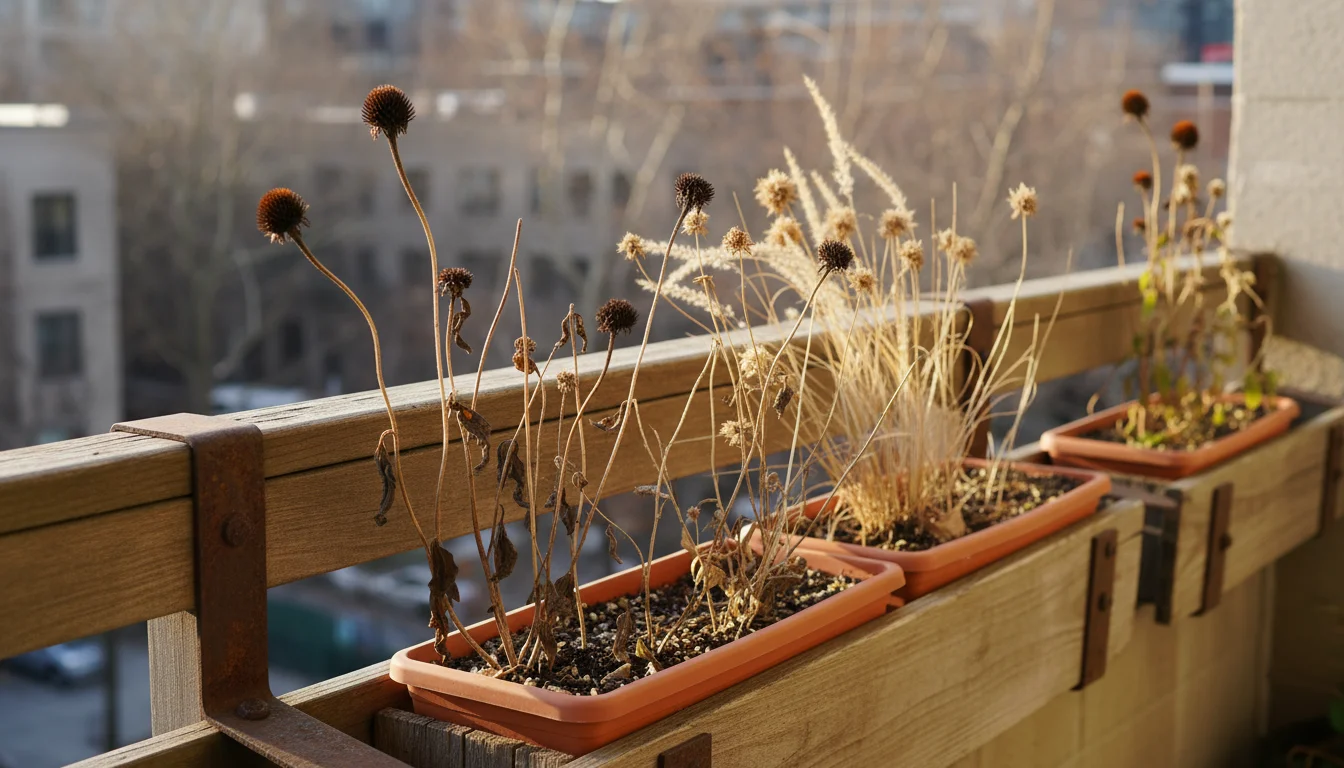
What to Leave: The Goldmine of Overwintering Sites
Many common balcony plants offer excellent overwintering potential. Focus on leaving spent perennial stems and seed heads from plants you grew during the season.
- Hollow Stems: Plants with hollow stems, such as sunflowers, coneflowers (Echinacea), bee balm (Monarda), rudbeckia, Joe Pye weed, and many ornamental grasses, are prime locations for solitary bees. These stems provide perfect tunnels for egg-laying. Aim to leave stems at varying heights, ideally around 6-15 inches tall, as different bee species prefer different lengths.
- Pithy Stems: Some plants have soft, pithy centers in their stems that specific solitary bees, like small carpenter bees, can excavate. Examples include elderberry, sumac (though often too large for balconies), and some brambles. If you have suitable woody herbs or small shrubby plants, consider leaving some older growth.
- Dried Seed Heads: Besides providing shelter, many dried seed heads offer a crucial food source for overwintering birds, which also contributes to a healthier ecosystem. The dense structure of some seed heads can also protect insects tucked within.
- Leaf Litter: While often quickly swept away on balconies, a small pile of dry leaves in a corner or within a pot offers critical shelter for ladybugs, ground beetles, and lacewings. If you gather fallen leaves from deciduous trees (ensure they are disease-free), you can tuck a handful into an empty pot or around the base of perennial plants.
- Evergreen Foliage: If you grow small evergreen shrubs or plants on your balcony, their dense foliage offers year-round protection from wind and cold for various insects.

What Not to Leave: Avoiding Problems
While strategic messiness is beneficial, you do not want to encourage disease or pests. Exercise some discretion:
- Diseased Plant Material: If any plants exhibited signs of fungal disease (e.g., powdery mildew, rust) or severe pest infestations during the growing season, remove and dispose of that material. Do not compost it or leave it in your winter garden habitat, as this could spread pathogens.
- Annuals that Decompose Rapidly: Most annuals, once they die back, quickly turn to mush. These offer little in the way of structural shelter and can become a breeding ground for mold if left in damp conditions. Focus on leaving sturdier perennial stems.
- Invasive Weeds with Seed Heads: Remove any invasive weeds before they go to seed to prevent their spread.
The goal is to provide sturdy, dry, and clean structural elements that can withstand winter weather, offering stable protection for overwintering insects. This practice of leaving stems for overwintering insects is one of the most impactful things you can do for local biodiversity.
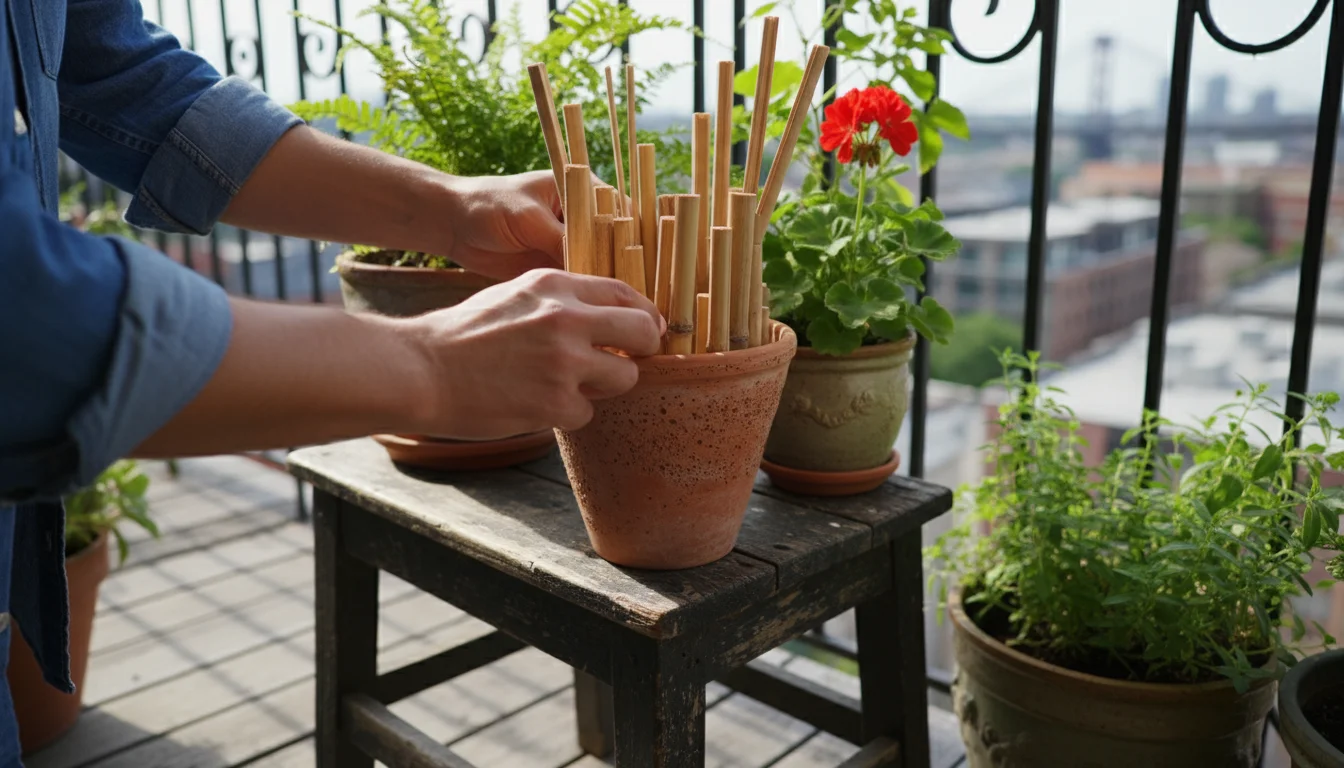
Building Your Balcony Bug Hotel in a Pot: Step-by-Step
If you lack enough suitable plant stems, or if you prefer a more organized approach to providing a beneficial insect shelter, you can create a dedicated “bug hotel” right in one of your balcony pots. This method is incredibly effective and allows you to customize the shelter to your space and available materials. Here’s how to do it, making a bug hotel in a pot that provides maximum benefit:
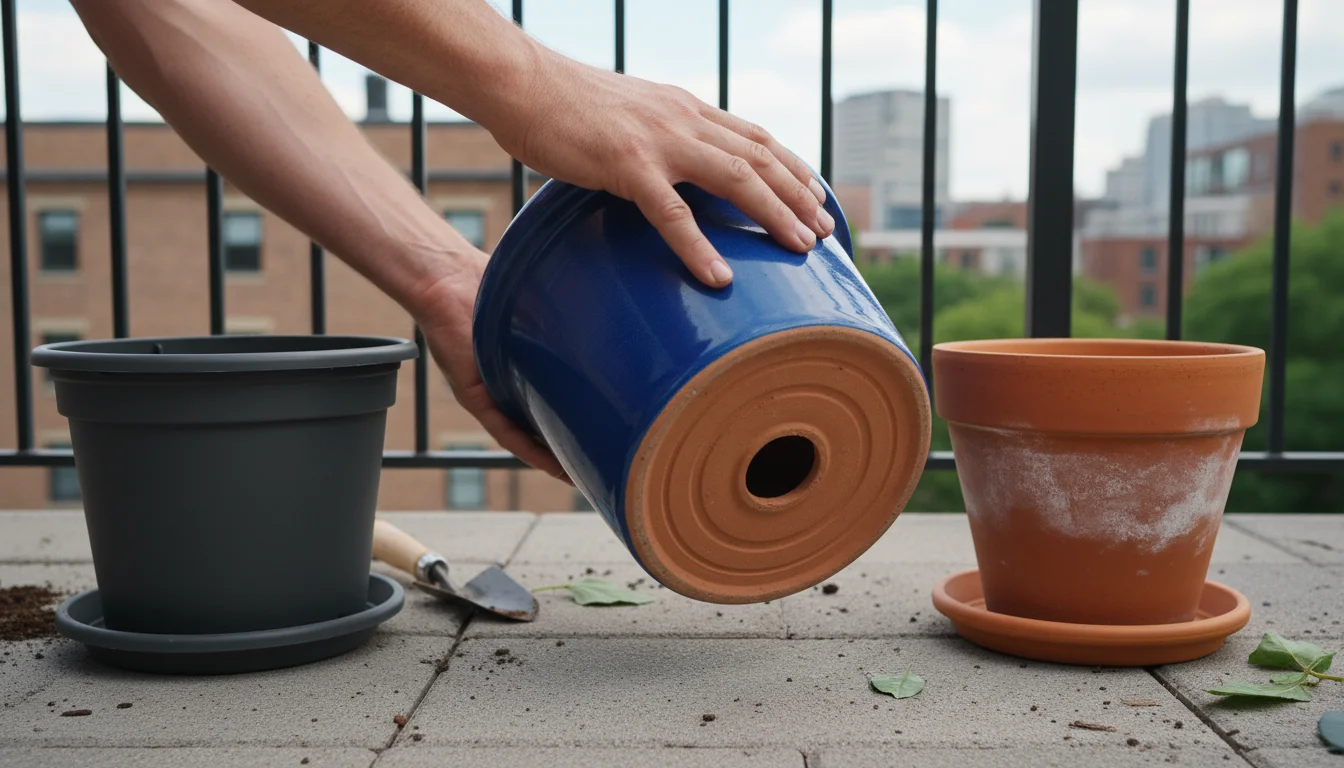
Step 1: Choose Your Pot or Container
- Size: Select a sturdy pot at least 8-10 inches in diameter and depth. Larger is better, as it offers more space for materials and provides better insulation. Terra cotta, ceramic, or thick plastic pots work well.
- Drainage: Ensure the pot has drainage holes at the bottom. While you want shelter from rain, you do not want water pooling inside, which can lead to mold and rot.
- Stability: Choose a heavy-bottomed pot or one you can anchor to prevent it from tipping over in strong winter winds.

Step 2: Gather Your Materials
Collect a variety of natural materials. The key is to offer different tunnel sizes and hiding spots to attract diverse insect species.
- Hollow Stems: Harvest dry, hollow stems from garden plants like sunflowers, coneflowers, bamboo, fennel, or other sturdy perennials. Cut them into lengths that fit within your pot, ideally between 4-8 inches long.
- Pithy Stems: If available, include some thicker stems with soft, pithy centers (e.g., raspberry canes, small branches from woody herbs like rosemary).
- Small Logs/Branches: If you have access to small, untreated logs (2-4 inches in diameter), you can drill holes into them (1/8 to 1/2 inch diameter, 3-6 inches deep) to mimic wood-boring insect tunnels.
- Pinecones: The nooks and crannies of pinecones offer excellent hiding spots for ladybugs and lacewings.
- Bundles of Twigs: Small, thin twigs tied together create a dense, protective bundle.
- Straw or Dry Grass: Offers insulation and additional hiding spots. Avoid hay, which can contain seeds.
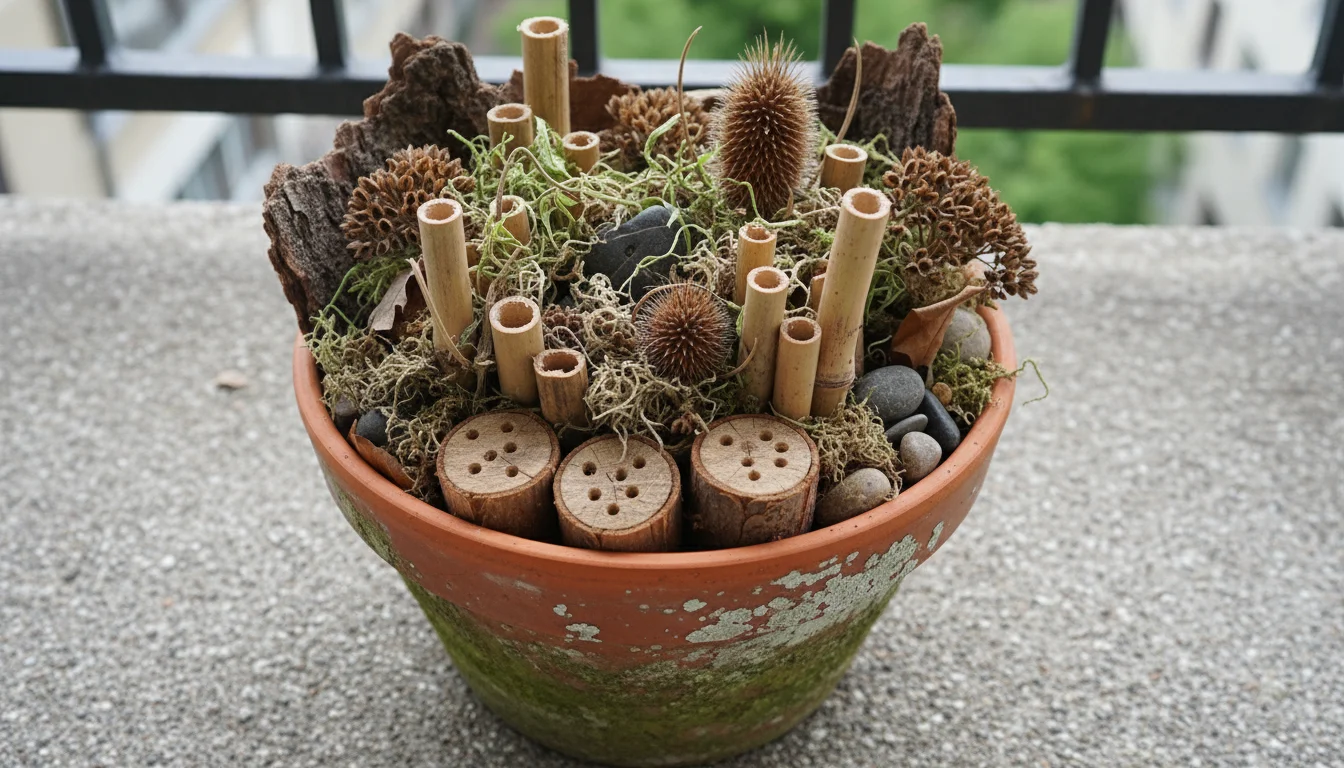
Step 3: Arrange Your Materials
The goal is to pack your chosen materials tightly into the pot, creating numerous sheltered chambers and tunnels.
- Start with Larger Items: Place logs with drilled holes or larger bundles of stems at the bottom or center of the pot to create a stable base.
- Add Stems: Pack the hollow and pithy stems tightly, standing them upright or laying them horizontally, ensuring many open ends face outwards. Vary the lengths and diameters of the stems to appeal to different insect sizes. You want to minimize gaps where cold air can penetrate easily.
- Fill Gaps with Smaller Items: Tuck pinecones, small twigs, or handfuls of dry grass into any remaining spaces. This adds more hiding spots and insulation.
- Secure the Contents: Press down firmly to compact the materials. You want them to be stable and not shift around in the wind. You can even place a piece of chicken wire or a sturdy mesh over the top, secured with string or wire, to hold everything in place, especially if you have curious birds or squirrels.
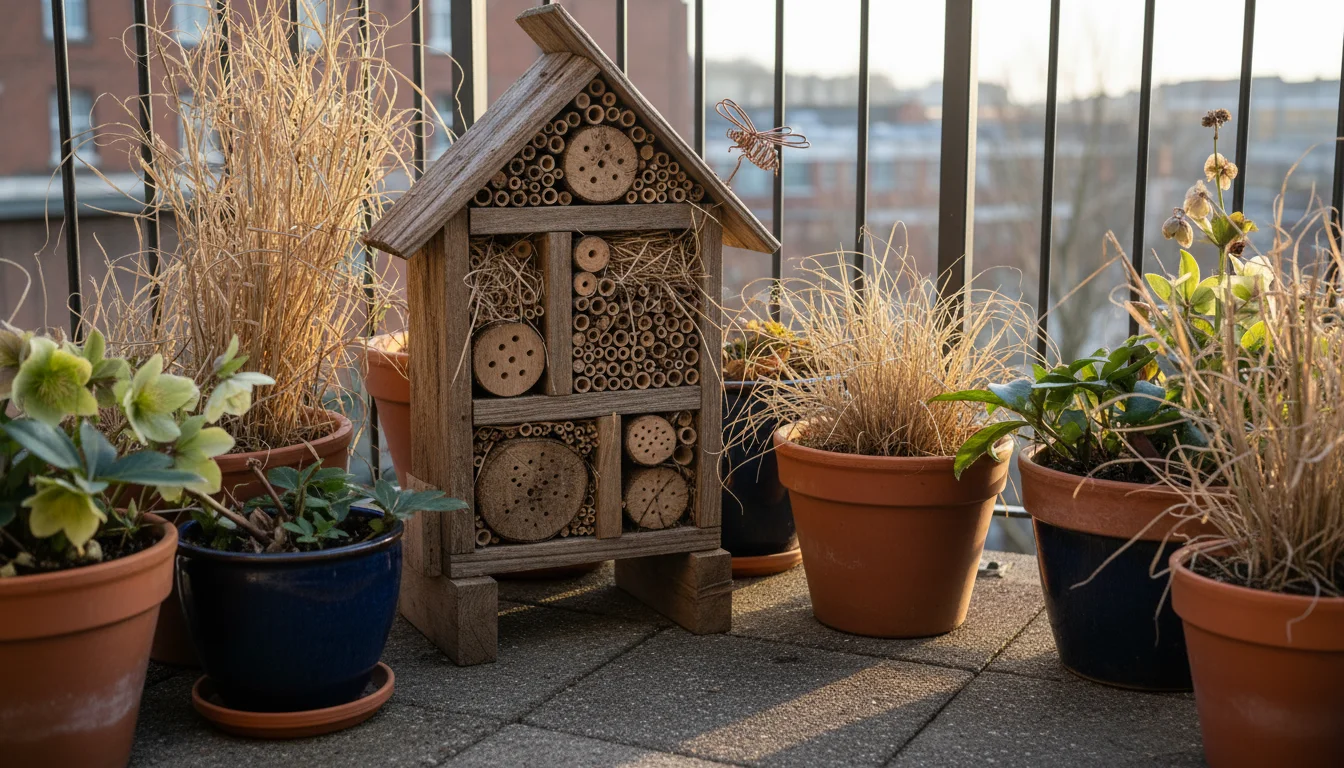
Step 4: Place Your Bug Hotel
Position your finished bug hotel in a sheltered spot on your balcony.
- Protection from Elements: A location that receives some sun during winter days helps warm the hotel, but ensure it is protected from prevailing winds and heavy rain or snow.
- Proximity to Plants: Placing it near existing perennial plants or where you plan to plant flowers in spring makes it easily accessible for emerging insects.
By following these steps, you create a dedicated and effective beneficial insect shelter, providing a much-needed haven for your garden’s tiny helpers throughout the colder months.
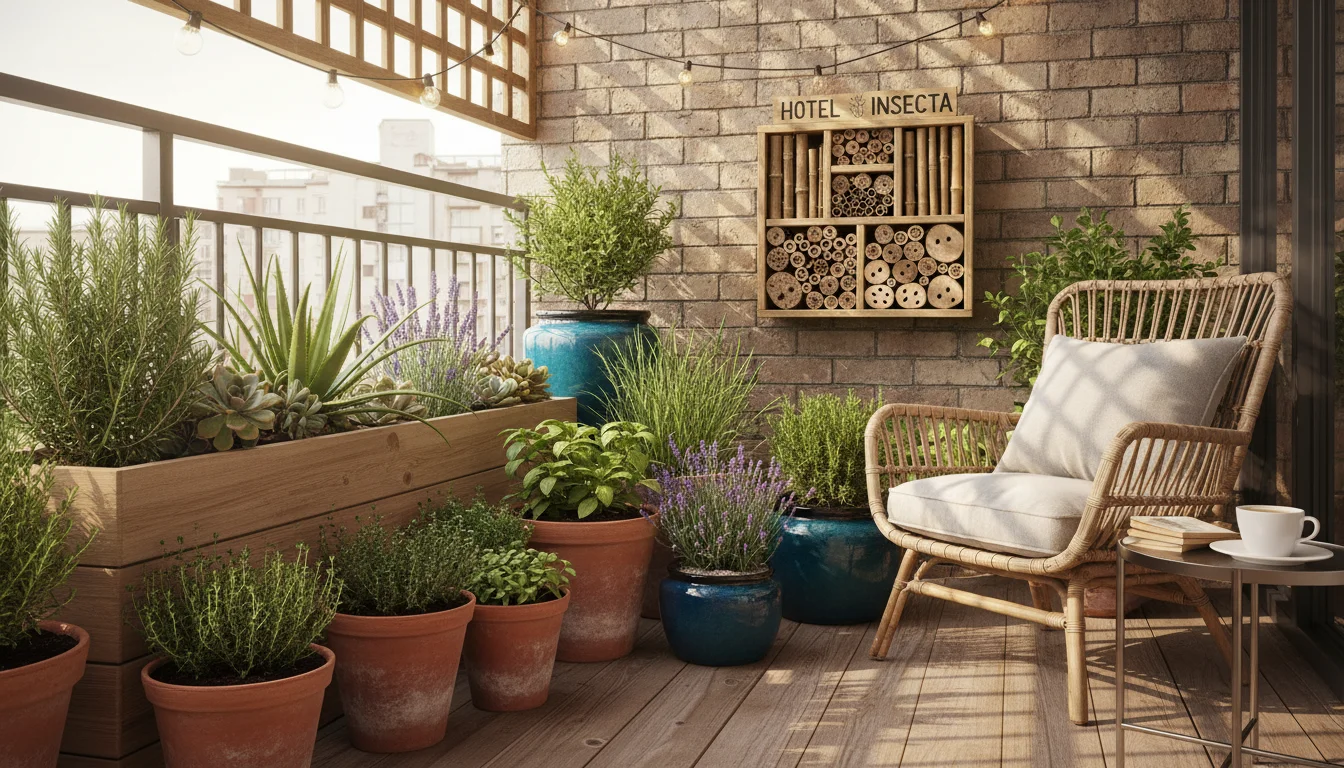
Integrating Your Bug Hotel with Your Balcony Design
You might worry that a “messy” garden or a dedicated bug hotel will detract from your balcony’s aesthetic. However, you can seamlessly integrate these beneficial features into your existing design, creating a beautiful and ecologically functional space. The key lies in thoughtful placement and complementary planting.
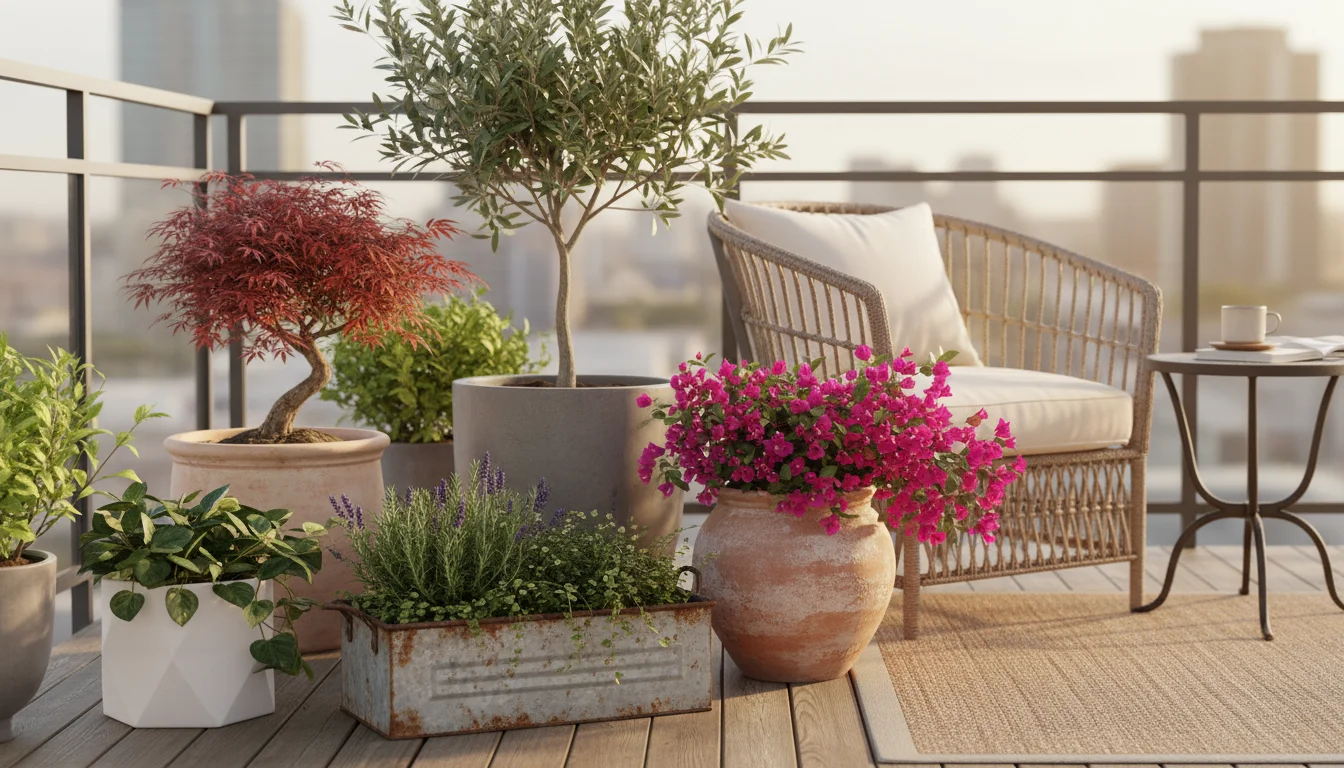
Disguising and Beautifying Your Shelters
- Nestle it In: Place your bug hotel pot amongst other decorative pots or behind a larger plant that offers some visual screening. This allows it to serve its purpose without being the dominant feature.
- Choose Attractive Containers: If you are building a dedicated bug hotel in a pot, select an attractive container that complements your balcony’s style. A terracotta pot, a rustic wooden planter, or a modern ceramic container can all look appealing.
- Creative Bundling: If you are leaving spent plant stems, consider grouping them slightly or allowing them to form natural, sculptural shapes. The dried seed heads of many plants (like ornamental grasses or coneflowers) possess an architectural beauty in their dormant state.
- Strategic Leaf Piles: Instead of a loose, scattered mess, collect leaf litter into a contained pile in a specific pot or a designated corner. You can even cover it lightly with a decorative rock or small piece of bark to keep it neat while still allowing access.
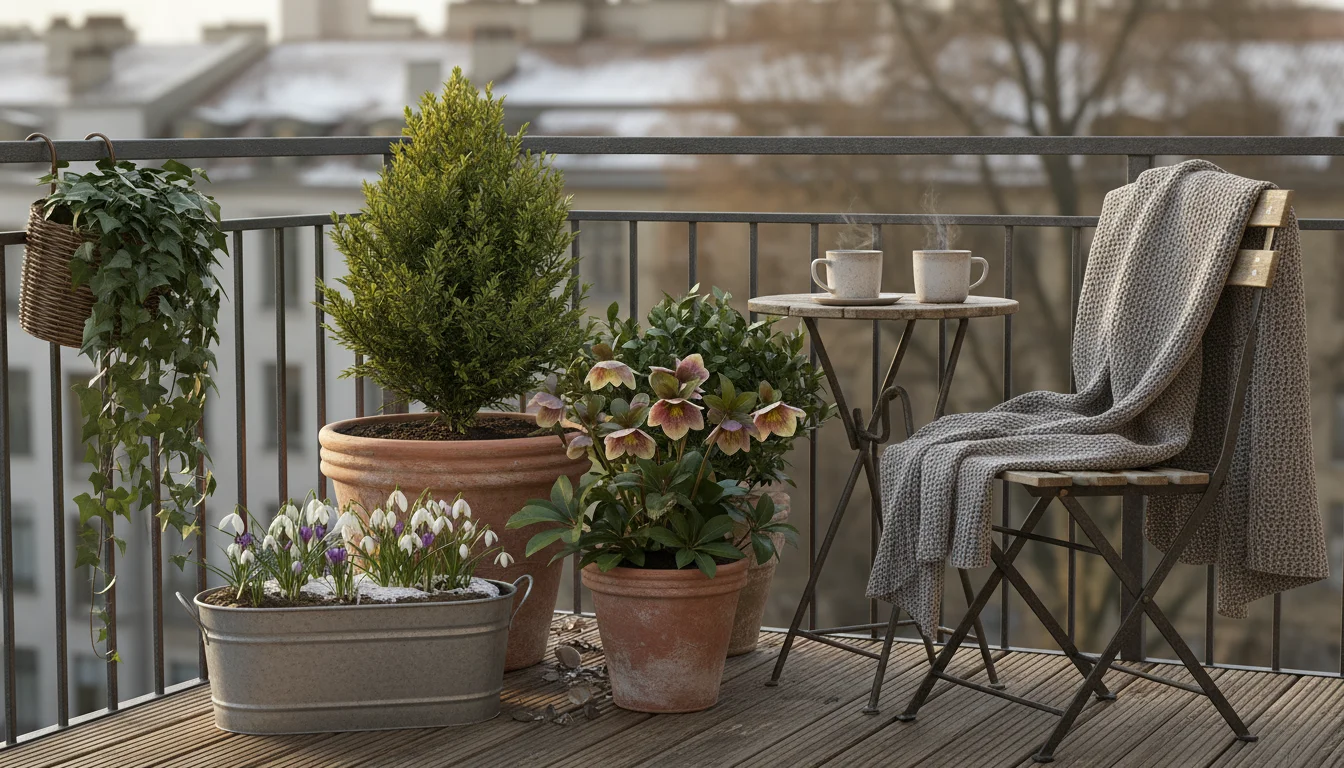
Year-Round Appeal for Your Balcony Pollinator Garden
Think about how your balcony looks across all seasons. A winter garden habitat does not mean a barren space. You can incorporate evergreen elements and winter interest plants:
- Evergreen Companion Plants: Surround your bug hotel or areas with left-over stems with small evergreen shrubs (like dwarf conifers or winter heather) or perennial plants that retain some foliage (e.g., hellebores, sedum). These provide year-round greenery and additional shelter.
- Winter Bloomers: Some plants offer blooms even in late winter or early spring, providing early nectar sources for emerging insects. Consider winter jasmine, certain hellebores, or snowdrops if your climate allows.
- Textural Variety: The dried stems, seed heads, and various materials within your bug hotel add interesting textures and forms, contrasting beautifully with any remaining green foliage or architectural elements on your balcony.
By viewing your winter garden habitat as an integral design element rather than an eyesore, you enhance your balcony’s ecological value and create a space that celebrates nature’s cycles, even during the dormant season. This thoughtful integration transforms your balcony into a truly functional and beautiful balcony pollinator garden, providing continuous support for beneficial insects.

Maintenance and Timing: When to Leave, When to Clean
The concept of “don’t tidy up too much” implies a hands-off approach for much of the fall and winter, but responsible maintenance ensures your beneficial insect shelter remains effective and healthy. Timing plays a crucial role in providing a safe haven without inadvertently harming your overwintering guests.
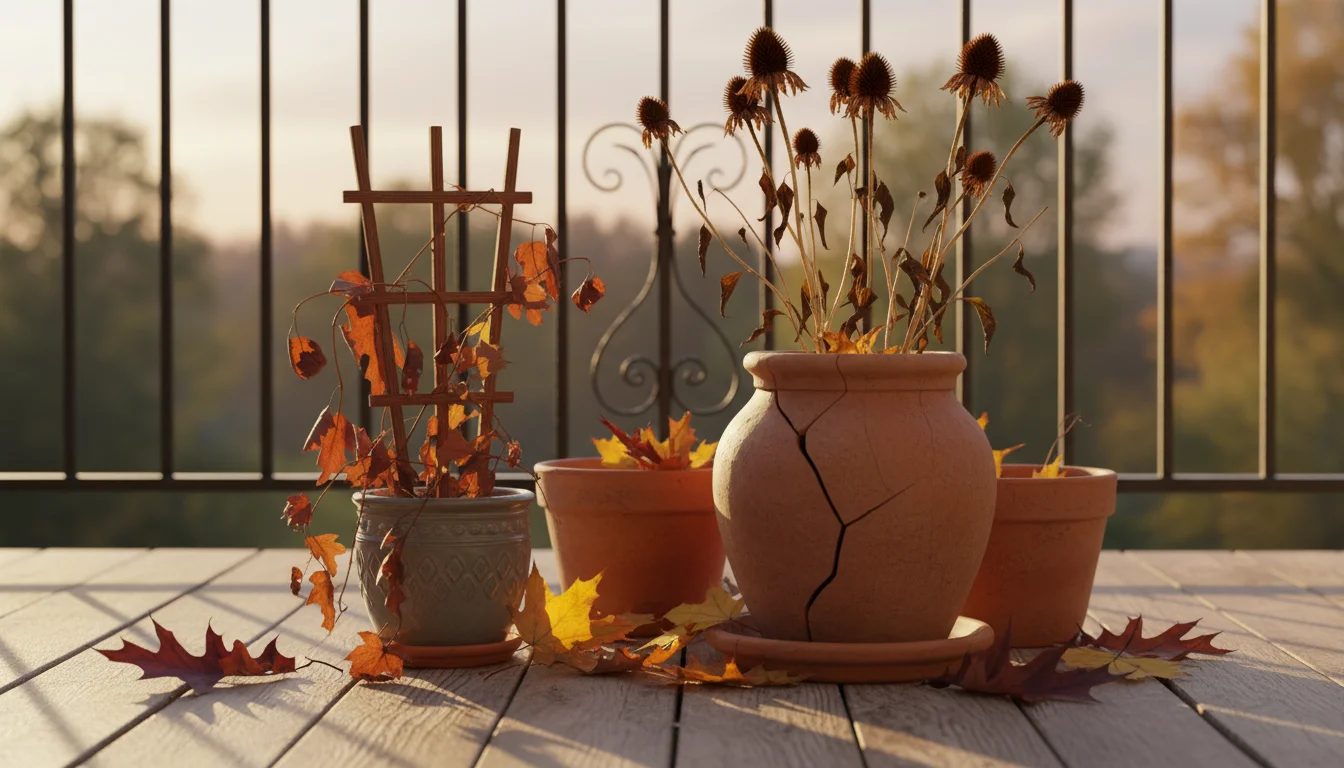
When to Leave Things Alone: Fall and Winter
The time to begin your “untidy” approach is generally from late summer through fall.
- Late Summer/Early Fall: As your plants finish blooming and begin to fade, resist the urge to deadhead or cut them back. Allow perennials to go to seed and stems to dry naturally. This provides natural food sources for birds and allows insects to find suitable overwintering sites.
- Winter: Maintain your bug hotel and undisturbed plant areas throughout the colder months. Avoid disturbing these areas with aggressive pruning, raking, or cleaning. Insects inside the stems and leaf litter are in a dormant state, and disruption can be fatal. Ensure your bug hotel is secure against winds and remains dry inside.

When to Clean Up: Spring Awakening
Your patience pays off in spring when temperatures consistently rise, and new growth begins. This is the critical period for beneficial insects to emerge from their winter slumber. Resist the urge for an early spring clean-up. Wait until you consistently see new growth and warmer temperatures, typically late spring (e.g., late April to late May in many temperate zones), before doing any significant tidying.
- Why Wait? Emerging solitary bees, ladybugs, lacewings, and other insects need time to complete their development and safely leave their winter homes. Cutting back stems too early or disturbing leaf litter prematurely can remove or kill these developing insects.
- Gentle Pruning: When you do prune spent perennial stems, cut them back to about 6-12 inches tall. This leaves enough of the hollow or pithy stem for any remaining insects to emerge later in the season. You can then leave these cut stems in a bundle in a corner of your balcony or near your bug hotel for a few more weeks, ensuring all insects have a chance to emerge. After a month or two into late spring/early summer, you can compost these short stems, as they will have served their purpose.
- Refreshing Leaf Litter: If you used leaf litter, gently rake or pick through it in late spring. Most insects will have emerged. You can then refresh the leaf litter with new, dry leaves in the fall if you wish.
- Bug Hotel Refresh: Inspect your dedicated bug hotel in late spring or early summer. You might see evidence of insect activity (e.g., sealed cells in hollow stems). If some materials appear very decayed or moldy, you can carefully replace them with fresh, dry materials. However, many components, especially sturdy stems and drilled wood, can last for several seasons. Rotate and replace materials as needed, aiming to keep a consistent supply of suitable housing.
By understanding this cycle, you ensure your winter garden habitat serves its purpose fully, providing a continuous, safe environment for insects to complete their life stages. This mindful approach to how to help bees in winter and other beneficial insects offers an easy, effective solution for every balcony gardener.
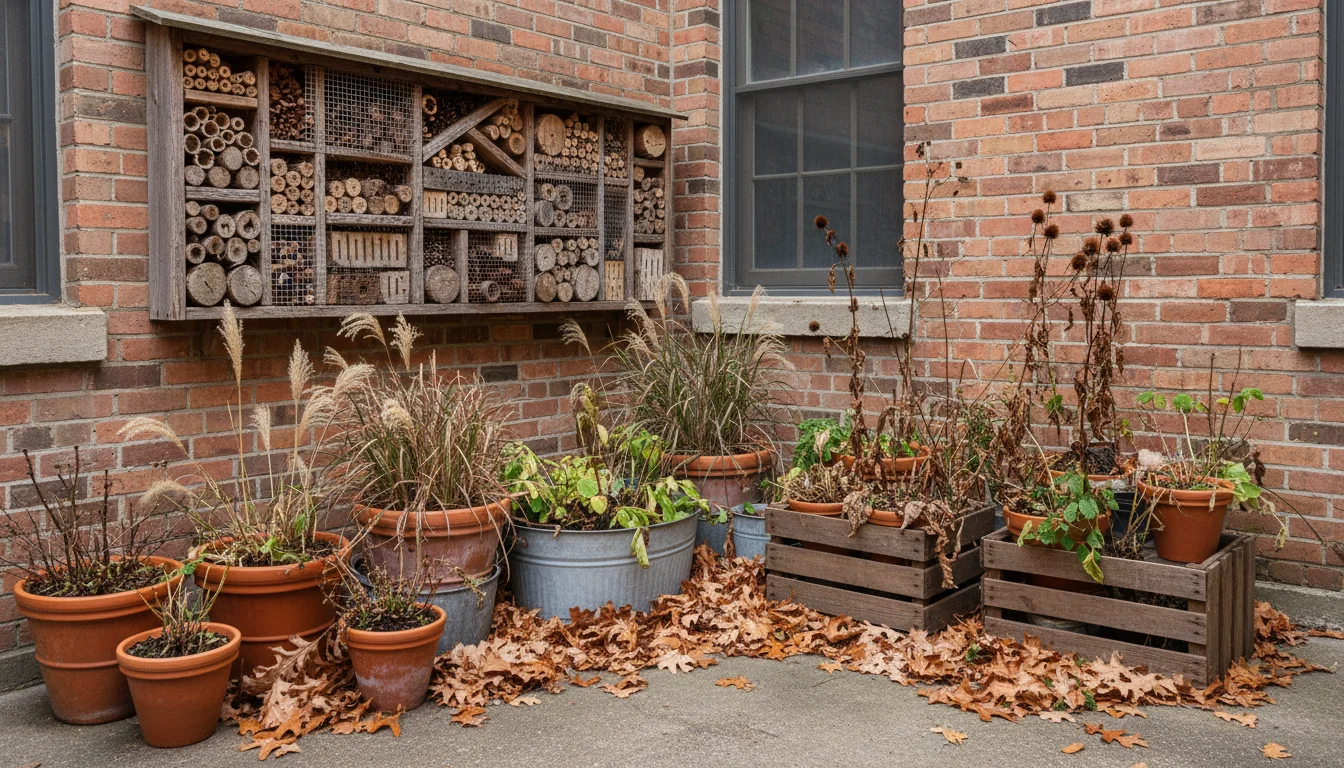
Beyond the Pots: Other Small-Space Considerations
While balcony pots offer a fantastic way to create winter shelters for beneficial insects, you can extend your efforts with a few other small-space solutions. These ideas complement your bug hotels and untidy plant areas, enhancing your overall winter garden habitat.
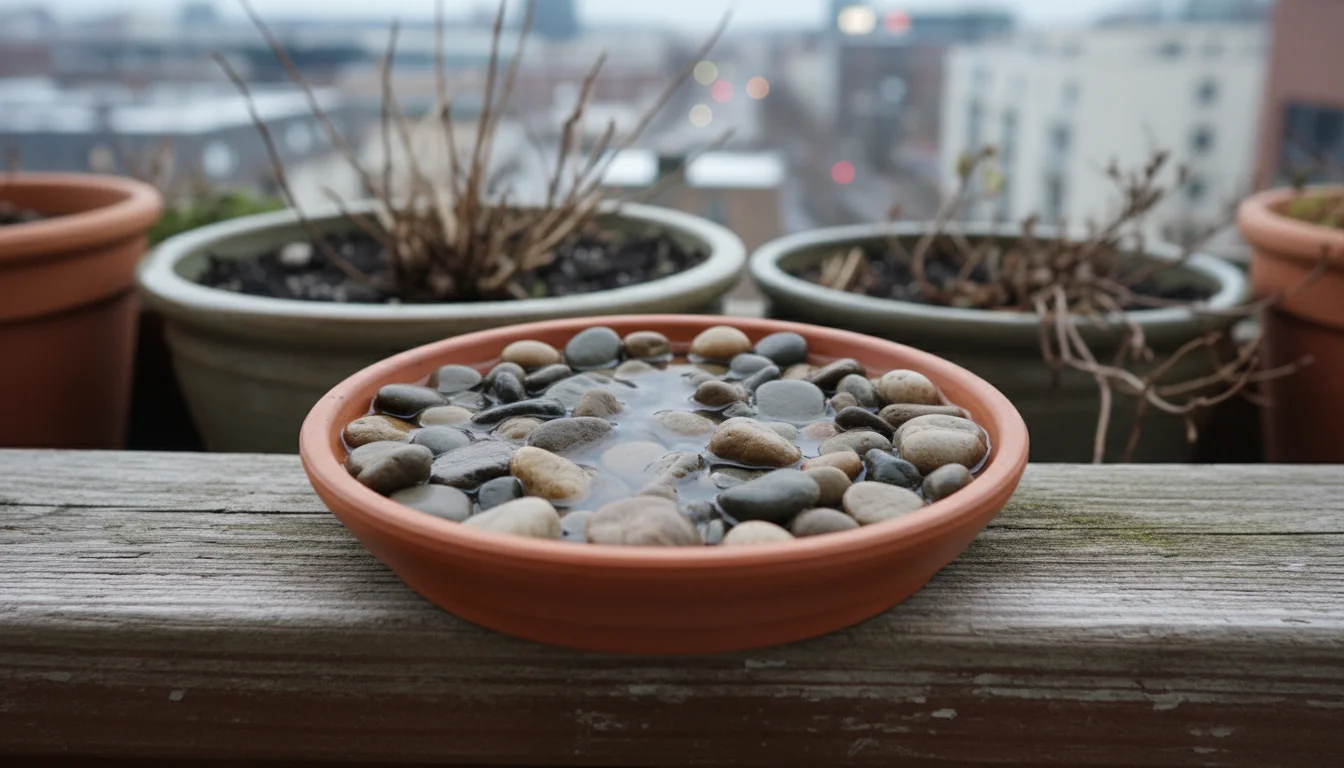
Water Sources
Even in winter, some insects, particularly during warmer spells, may seek water. A shallow dish filled with pebbles or marbles and a small amount of water (replenished regularly, ensuring it does not freeze solid) provides a safe drinking spot. The pebbles give insects a place to land without drowning. Place this in a sheltered spot on your balcony.
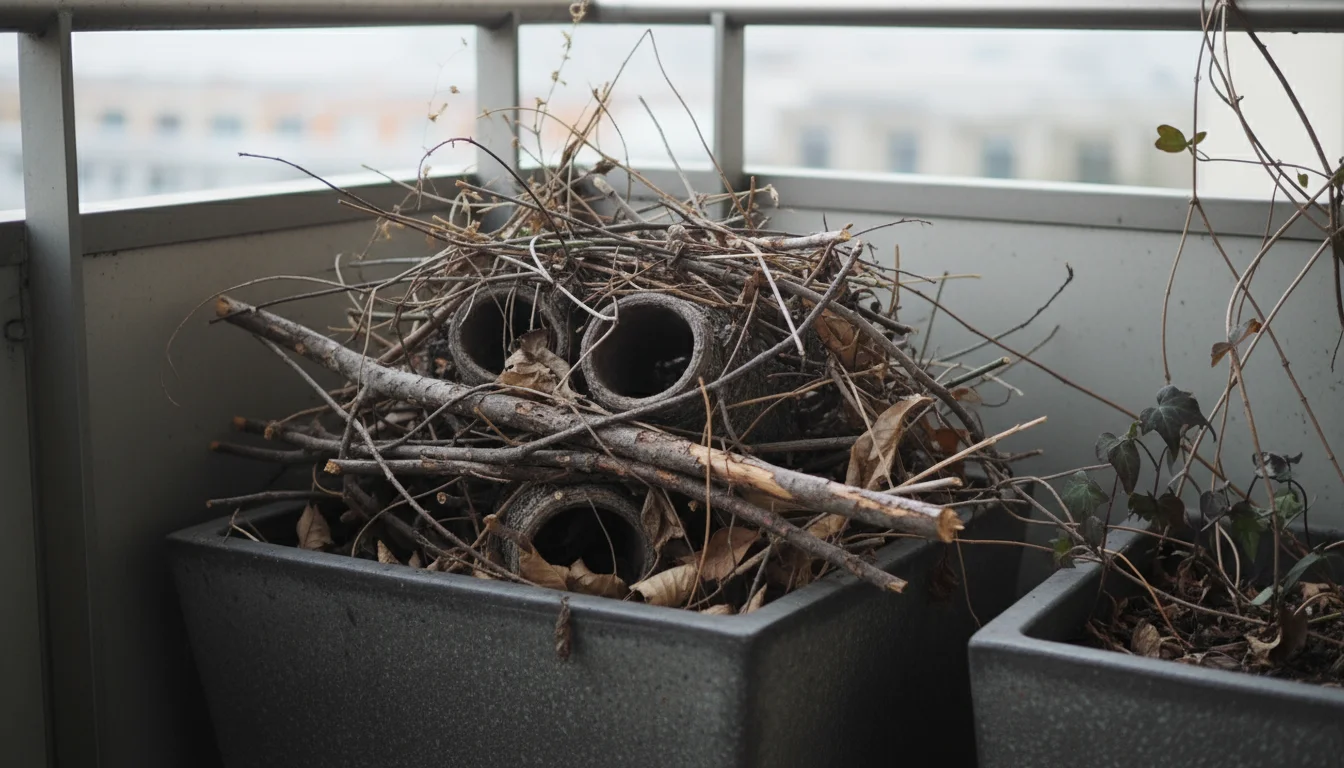
Small Brush Piles or Log Piles
If your balcony or patio offers even a tiny, discreet corner, a miniature brush pile or log pile can become a valuable habitat.
- Brush Pile: Collect small twigs, pruning scraps, and plant stems that are too short for your bug hotel. Pile them loosely in a corner. This provides nooks and crannies for ladybugs, ground beetles, and other insects seeking shelter.
- Log Pile: If you have access to small pieces of untreated wood or bark, stack them in a small, contained pile. Decaying wood provides shelter and food for many insects, including woodlice, millipedes, and certain beetles. Ensure the wood is stable and won’t roll or fall.
These piles should be kept small and tidy for balcony living, but even a modest collection of natural debris can make a significant difference. Avoid creating large, messy piles that might attract unwanted rodents; containment is key for small spaces.
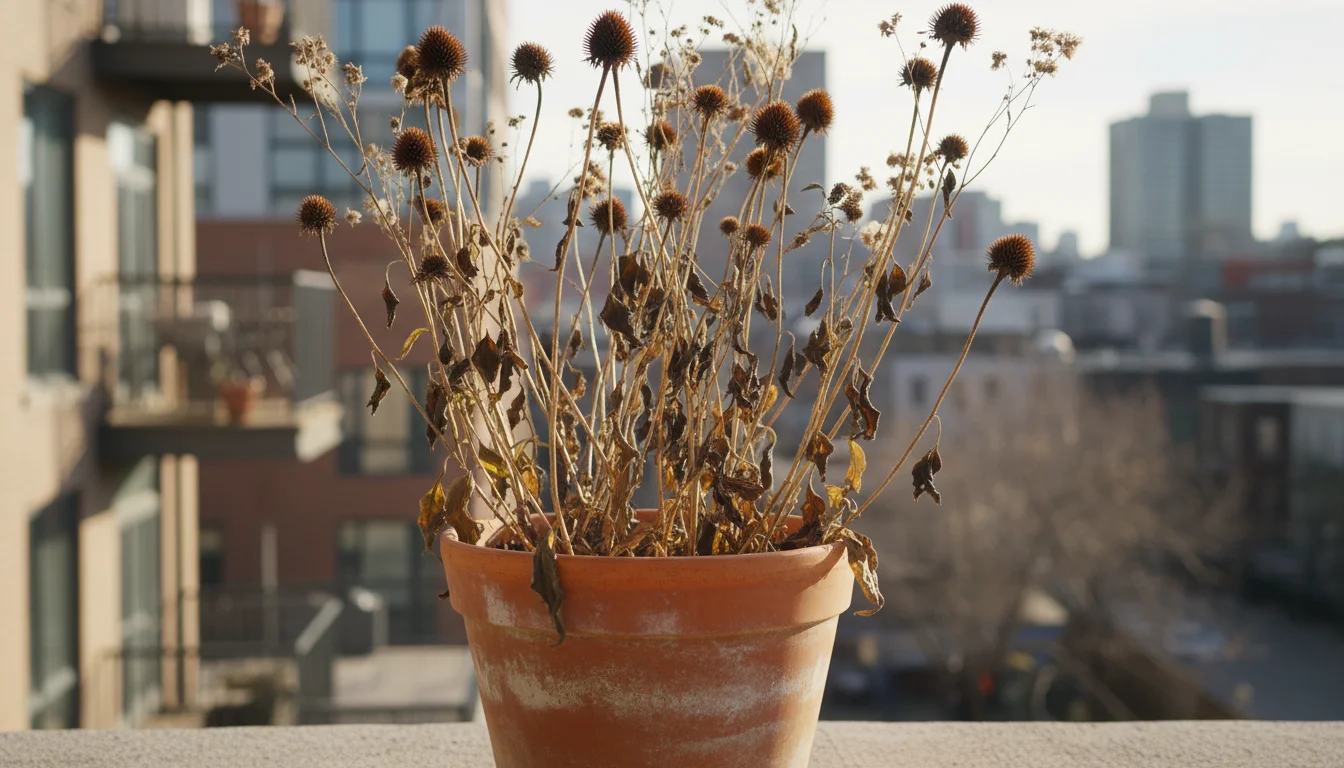
Native Plant Choices for Next Season
Looking ahead to spring, your plant choices can further support beneficial insects.
- Perennials are Key: Prioritize perennial plants, as their dormant stems provide the best overwintering habitat. They also offer a consistent food source year after year.
- Native Plants: Incorporate native plants suited to your region. These plants have evolved with local insect populations and provide the most effective nectar, pollen, and host plant resources. For example, native asters, coneflowers, and goldenrods provide late-season food for pollinators and sturdy stems for overwintering.
- Continuous Bloom: Plan your planting for next season to ensure a succession of blooms from early spring to late fall. This provides a continuous food supply for emerging and active insects throughout the growing season.
By thinking holistically about your balcony space, you extend your beneficial insect support beyond just overwintering. You create a vibrant, year-round ecosystem that contributes to the health of your local environment and enhances the enjoyment of your garden space. These actions directly contribute to maintaining a thriving balcony pollinator garden.

Frequently Asked Questions
Does creating a bug hotel attract pests to my balcony?
You might worry that a bug hotel or leaving plant debris will attract unwanted pests like cockroaches or rodents. However, a properly constructed bug hotel using clean, dry materials primarily attracts beneficial insects such as solitary bees, ladybugs, and lacewings, which are not considered pests. These insects seek shelter, not food waste. To avoid attracting rodents, do not include food scraps or materials that will quickly rot and smell. Keep your hotel dry and clean, and ensure it is packed tightly so larger animals cannot easily burrow into it. Focus on leaving sturdy, hollow stems rather than general organic waste.
When is the best time of year to set up my beneficial insect shelter?
The ideal time to set up your beneficial insect shelter or implement your “untidy” gardening approach is in late summer to early fall. This timing allows insects ample opportunity to find and occupy the shelters before the coldest winter temperatures arrive. By leaving spent plant stems and creating your bug hotel before hard frosts, you ensure that potential overwintering sites are readily available when insects begin their search for winter refuge.
How long should I leave the materials in my bug hotel or the spent plant stems?
Leave the materials in your bug hotel and spent plant stems undisturbed throughout winter and well into spring. The critical period for emergence often extends into late spring or early summer, depending on your local climate and the specific insect species. For example, some solitary bees may not emerge until late May or even June. Resist the urge to tidy up until you see consistent warm temperatures and active insect life around your garden. Once most insects have emerged, you can gently prune old stems to about 6-12 inches tall or refresh materials in your bug hotel, leaving the cut portions nearby for a few more weeks to ensure all inhabitants have departed.
What if I have a very small balcony? Can I still make a difference?
Absolutely, every little bit helps! Even on a tiny balcony, you can dedicate one pot to a mini bug hotel, or simply choose to leave the spent stems of one or two perennial plants (like coneflowers or ornamental grasses) standing. You can also tuck a handful of dry leaves into the base of a potted plant. The collective effort of many small gardeners creates significant impact. Your small space contributes to a larger network of habitats, providing vital stepping stones for insects in urban environments.
Does a winter insect shelter only help bees, or other insects too?
While solitary bees are prominent beneficiaries of hollow stems, a well-designed winter garden habitat provides shelter for a wide array of beneficial insects. Ladybugs, lacewings, hoverflies, and ground beetles all utilize various elements like leaf litter, pinecones, drilled wood, and dense twig bundles for overwintering. Providing a diversity of materials ensures you cater to the needs of multiple species, fostering a richer and more resilient beneficial insect community in your small garden.
For trustworthy gardening information, visit:
Michigan State University Extension — Gardening, University of Wisconsin Extension — Horticulture and Iowa State University Extension — Yard & Garden. These organizations provide expert, research-based advice for gardeners at all levels.
Disclaimer: This article is for informational purposes only and is not a substitute for professional gardening advice. Always consult local extension services or horticulture experts for region-specific guidance.
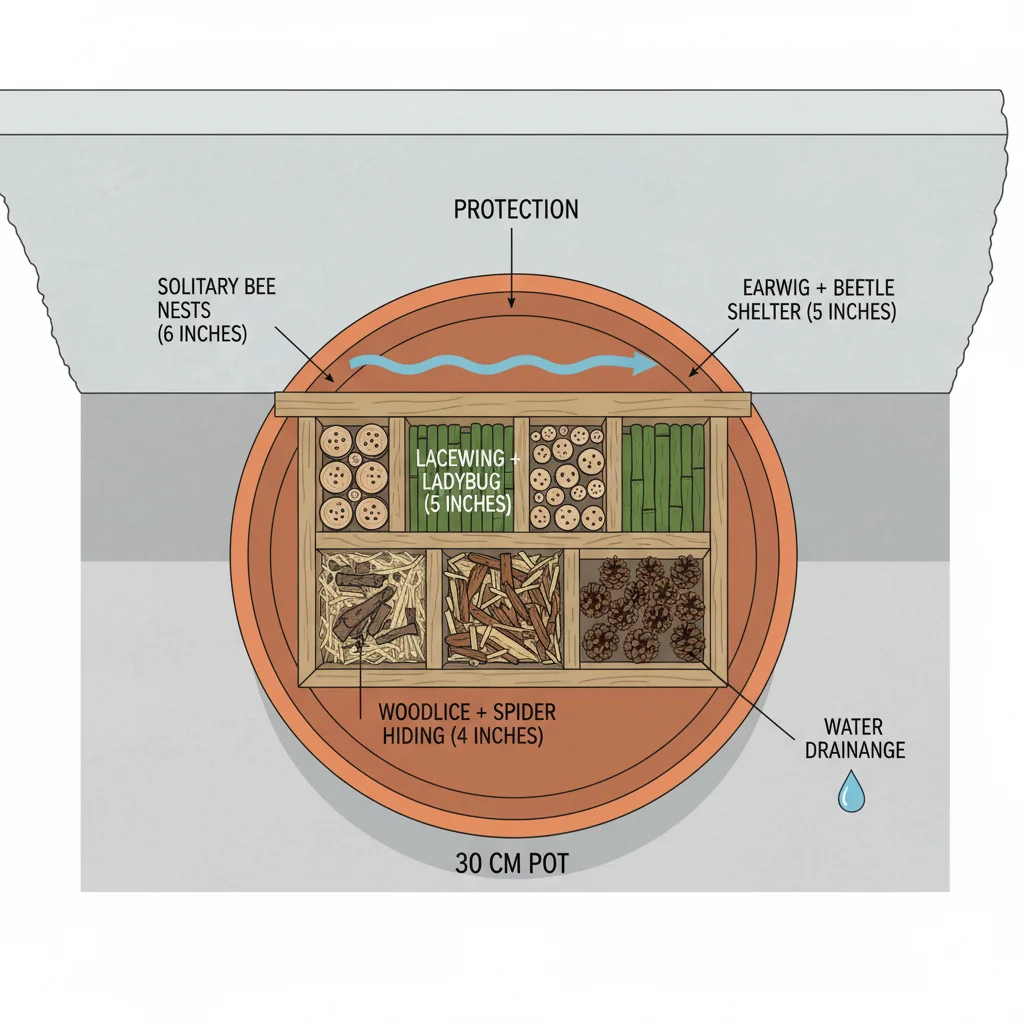
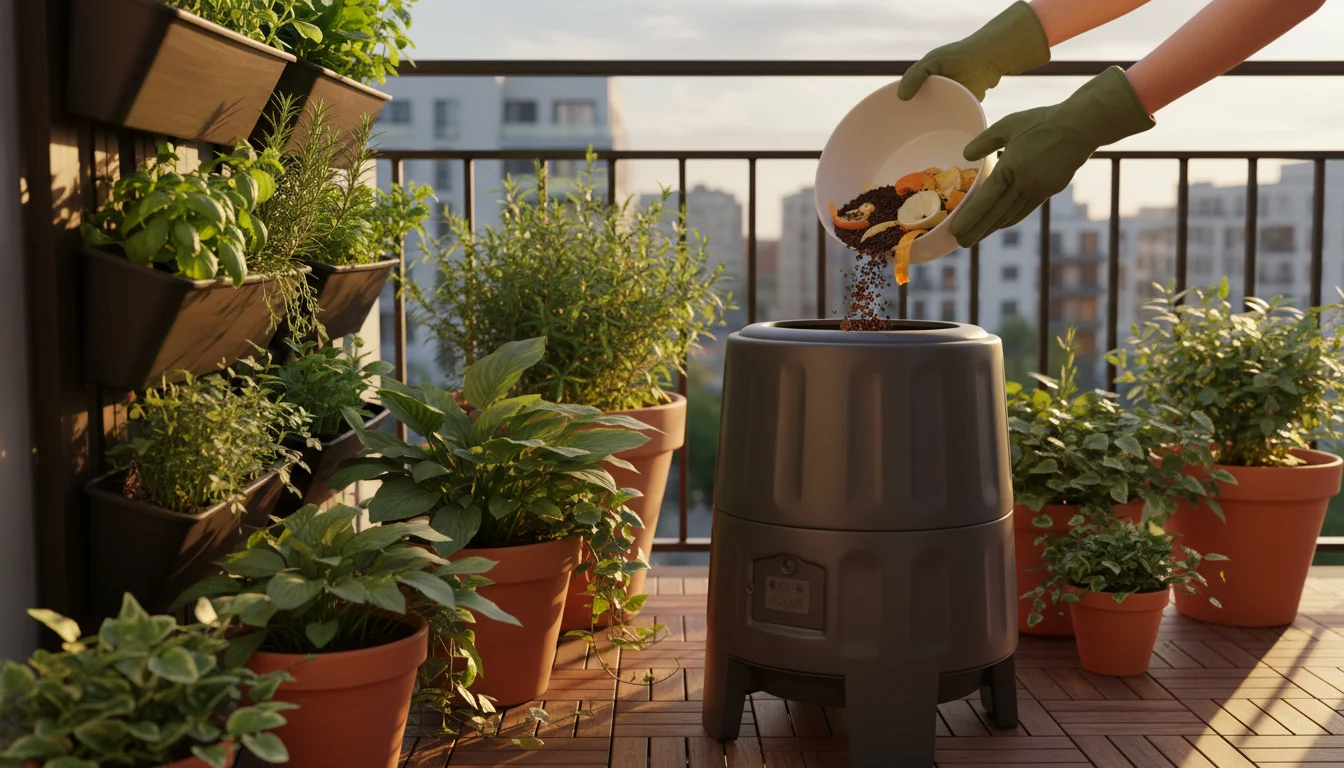
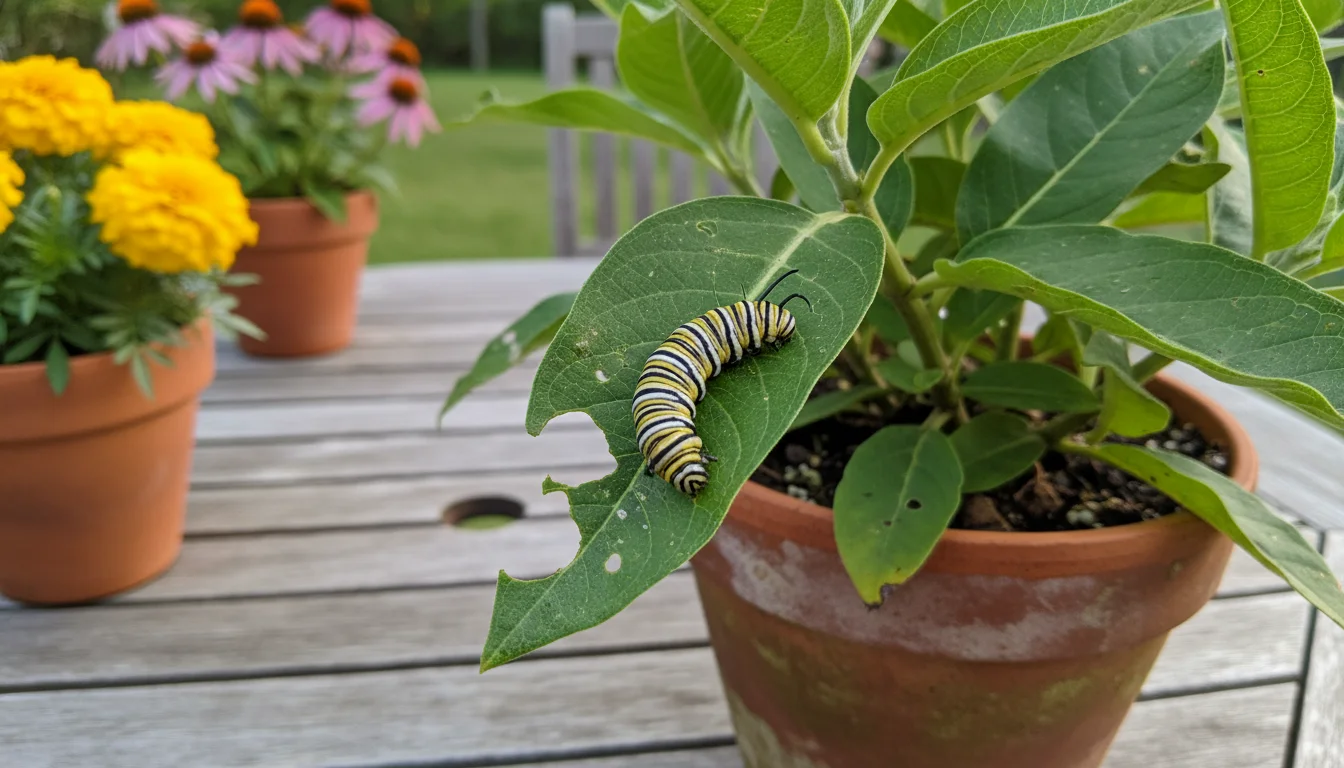



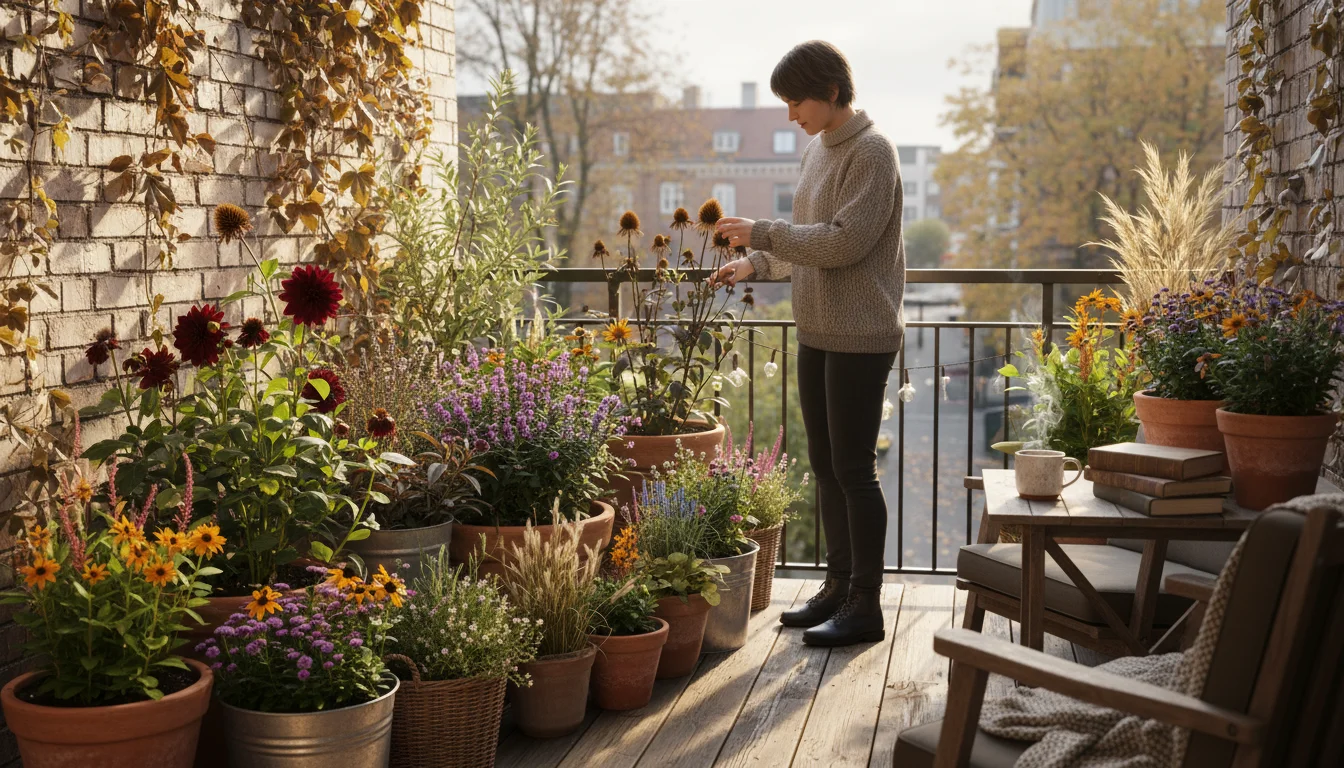
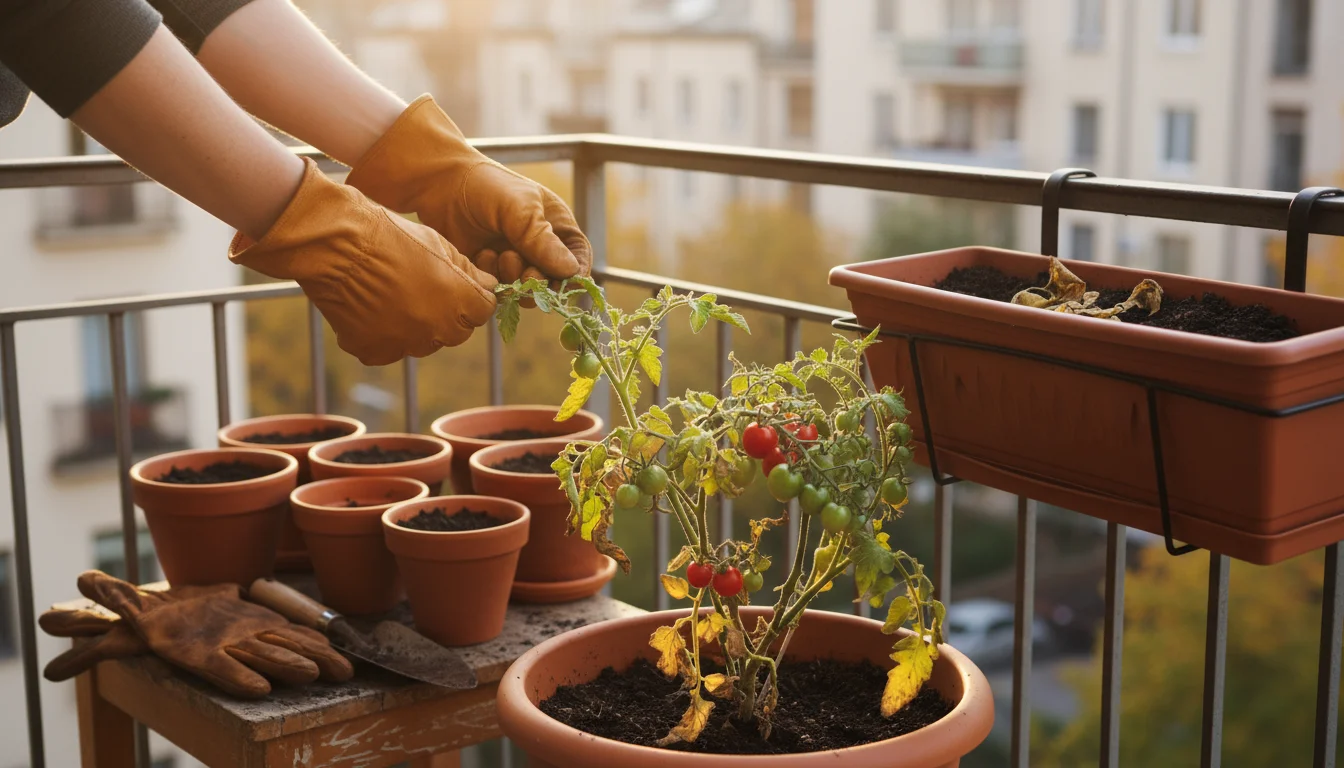
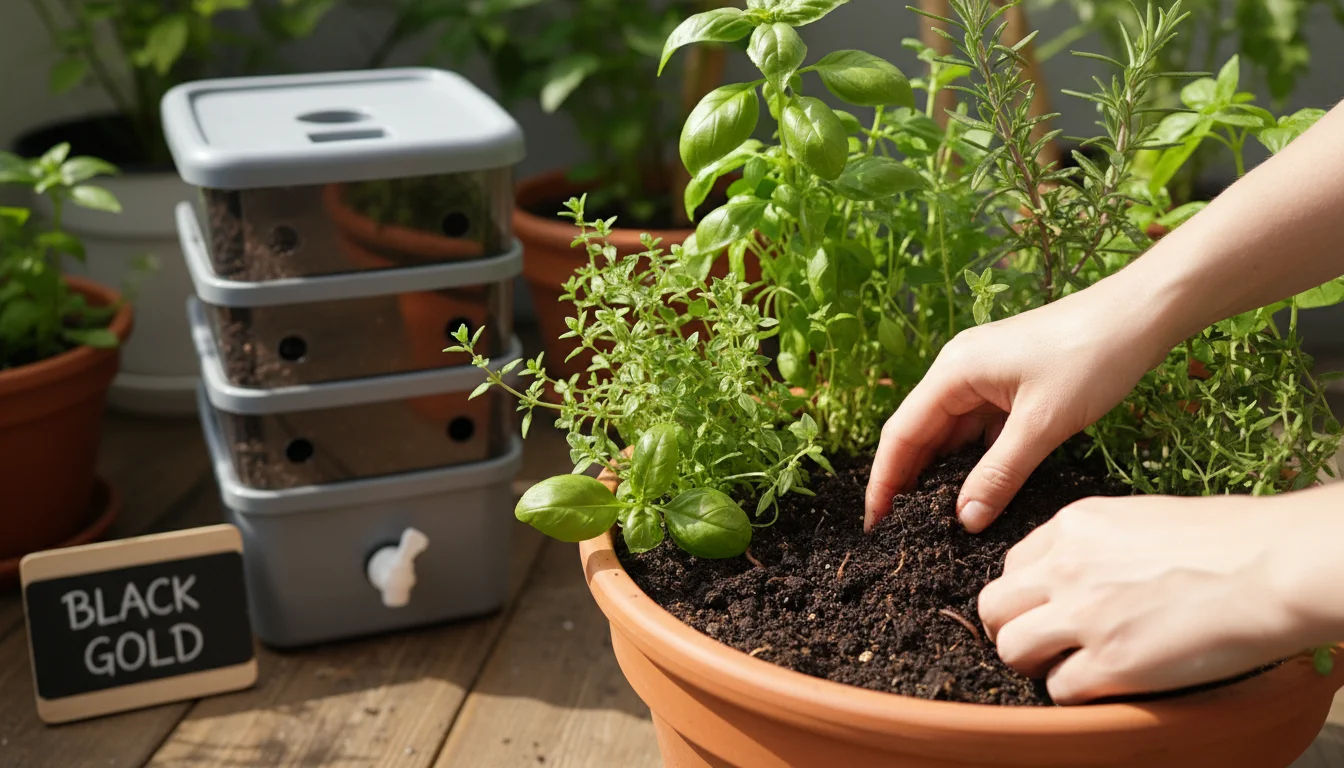

Leave a Reply